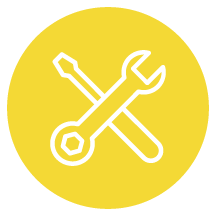“The most effective way to teach a complex concept is by identifying what is the most complex [piece], and take the time to understand it, before communicating it to your learners.”
–How to explain complex concepts blog

A system is like a puzzle. Let’s build the puzzle together, piece by piece. In this image, there are many white jigsaw puzzle pieces on a white background. (Mel Poole via Unsplash)
By Noah Kaiser, Intern at Agenda for Change
In my first blog, I used a puzzle to explain water, sanitation, and hygiene (WASH) systems and what it means to make these systems strong. Now, I’m going to start building this puzzle using pieces that we call Building Blocks.
What are ‘Building Blocks’?
Like a puzzle you might build at home, the water and sanitation puzzle has many pieces. However, this puzzle is different from a normal puzzle because it’s very hard to see all of the pieces at once, and different groups of people own or work with the different pieces. This means that no one person or organization can build the puzzle by themselves, and even with the help of others, it still takes a long time.
We need to work together to learn about the size and shape of each piece and figure out how they connect to the others. We also have to work with other puzzle-builders over time to understand the whole puzzle and build it completely. Sometimes during this process, we might find out that an important piece is missing – for example, when there isn’t enough money in the system to pay workers who keep water flowing every day.
Agenda for Change talks about eight special puzzle pieces, called Building Blocks. In this blog, I’ll attempt to simply explain two of the building blocks, called Service Delivery Infrastructure and Institutional Arrangements and Coordination.
People, pipes, and pumps
Let’s look at the physical parts of the system, which are called “infrastructure”, as the first puzzle piece. These are pieces of the system we can all see, like toilets and sinks, and those we can’t, like water pumps and pipes in the ground. As well as the infrastructure, we depend on well-trained people to keep all of the pieces working properly, we call this “service delivery.”

Service Delivery Infrastructure: This puzzle piece includes things like pipes, toilets, and sinks, and all the well-trained people who keep things working all day, every day.
In a strong system, most people have sinks and toilets that they can use easily and safely. They can afford to pay their bills, which helps the people who are responsible for keeping water flowing and for safely managing waste to have all of the money and tools they need. In this situation, the responsible people are well-trained and prepared to keep sinks and toilets working properly, and they know how to fix broken pipes or pumps quickly if they break.
In a weak system, not everyone can use working sinks and toilets. Others do have sinks or toilets, but they might be old, broken, too far away, or too dirty to use. This makes going to the bathroom and washing up hard, and sometimes, not safe. In a weak system, there aren’t enough well-trained people around who can fix broken sinks or toilets. People responsible for keeping water flowing might run out of money for repairs – which sometimes happens because water users can’t afford to pay their water bills.
Who’s the boss?
This puzzle piece describes the people in national, city, or town governments who make decisions, plans, and budgets, and things that we call “institutional arrangements,” that impact water and sanitation systems. Often, they live in different cities, which means that sometimes the water people don’t work in the same office as the toilet people. To do their jobs well, and to build a strong system, it is helpful for them to know what people in other parts of government are doing and how to talk with those people, we call this “coordination.”
 Institutional Arrangements and Coordination: This puzzle piece includes the people in national, city, or town government within a country who make plans, decisions, and rules, and the ways that they talk to and work with each other.
Institutional Arrangements and Coordination: This puzzle piece includes the people in national, city, or town government within a country who make plans, decisions, and rules, and the ways that they talk to and work with each other.
In a strong system, there are water and sanitation laws, regulations, plans, and budgets in place that people follow and use to make the system strong. People who work in the government, from small towns all the way to the national capital, clearly understand their jobs and are well-trained. They have all of the tools, ideas, and money that they need to do their job well and they talk responsibly with other government workers to share plans and ideas.
In a weak system, the jobs of government staff are not clear to them or other people, or there aren’t enough staff with the right skills to get the job done right. The staff might not have enough information, time, or money to make the important decisions, plans, and budgets to keep the water and sanitation system working. Sometimes, different government staff do their jobs without talking to each other, which can lead to wasting time or money, or even making mistakes. In other situations, government staff does bad things without thinking about the people of the city, town, or country.
Service Delivery Infrastructure and Institutional Arrangements and Coordination are two important Building Blocks within the water and sanitation system, but there are still six more to talk about! Interested in reading more? Stay tuned for Part 3 of the ‘Simple Explanation’ series, where we will keep building the puzzle.

Noah Kaiser is an Intern at Agenda for Change who is passionate about the application of systems-thinking in a global WASH sector. He also works as a teaching assistant and research assistant within the Mortenson Center in Global Engineering, at his alma mater the University of Colorado at Boulder, from which he holds a BS in Mechanical Engineering and an MS in Civil Engineering. Noah’s research and career interests span WASH, rural transportation infrastructure, disaster risk reduction, food security, and the humanitarian aid and development nexus.
